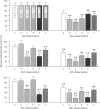Abstract
1. The dual inhibitor of enkephalin degrading enzymes, RB 101, is able to block endogenous enkephalin metabolism completely, leading to potent antinociceptive responses potentiated by blockade of CCKB receptors. In this study we have investigated the effects induced by RB 101 given alone, or with the CCKB antagonist, PD-134,308, on a model of spontaneous morphine withdrawal and substitutive maintenance in rats. 2. Animals were chronically treated with morphine for 7 days followed, 36 h after the interruption of drug administration, by a maintenance treatment for 5 days with methadone (2 mg kg-1, i.p.), clonidine (0.025 mg kg-1, i.p.), RB 101 (40 mg kg-1, i.p.), PD-134,308 (3 mg kg-1, i.p.) or a combination of RB 101 plus PD-134,308. Several behavioural observations were made during this period in order to evaluate the acute effects as well as the consequence of chronic maintenance induced on spontaneous withdrawal by the different treatments. 3. Methadone was the most effective compound in decreasing the spontaneous withdrawal syndrome after acute administration. Both, methadone and RB 101 had similar effectiveness in reducing opiate abstinence during the period of substitutive treatment. PD-134,308 did not show any effect when administered alone and did not modify the effect of RB 101. 4. Naloxone (1 mg kg-1, s.c.) failed to precipitate any sign of withdrawal when injected at the end of the chronic maintenance treatment suggesting that, under the present conditions, methadone and RB 101 did not induce significant physical opiate-dependence. 5. The mildness of the side effects induced by chronic RB 101, suggests that systemically active inhibitors of enkephalin catabolism could represent a promising treatment in the maintenance of opiate addicts.
Full text
PDF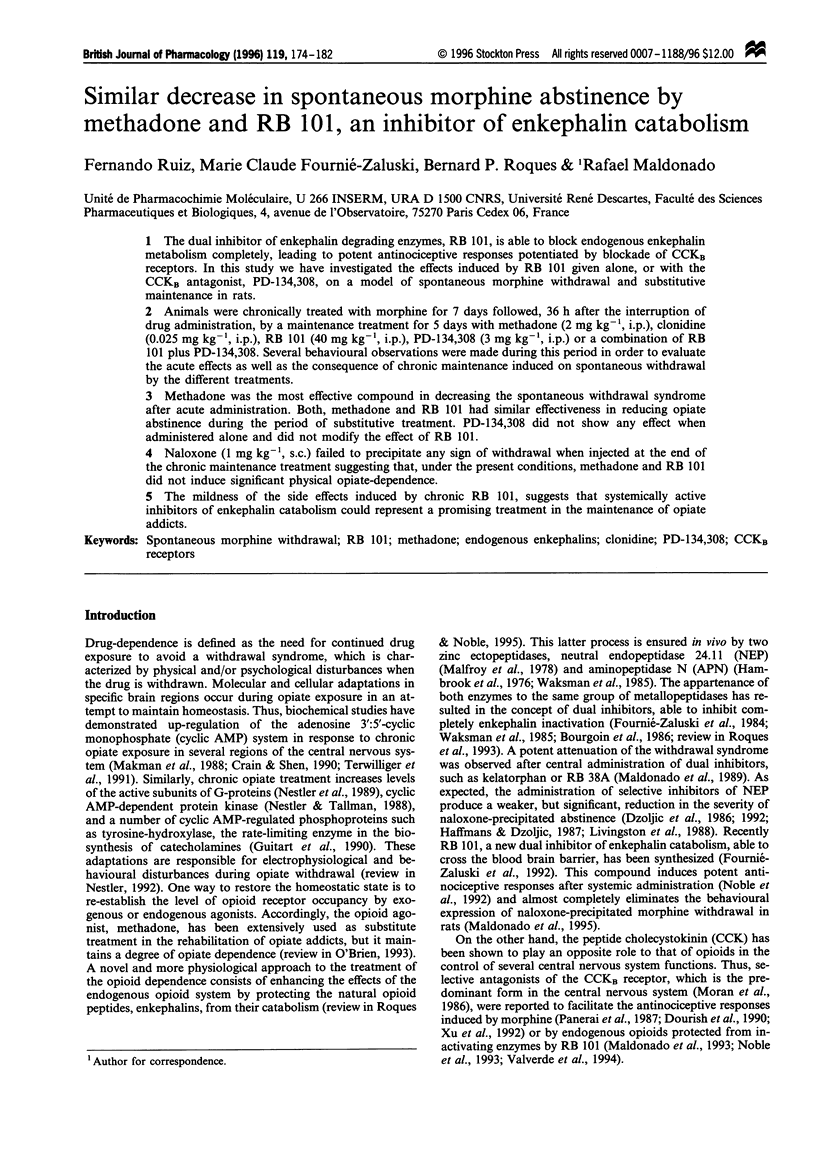
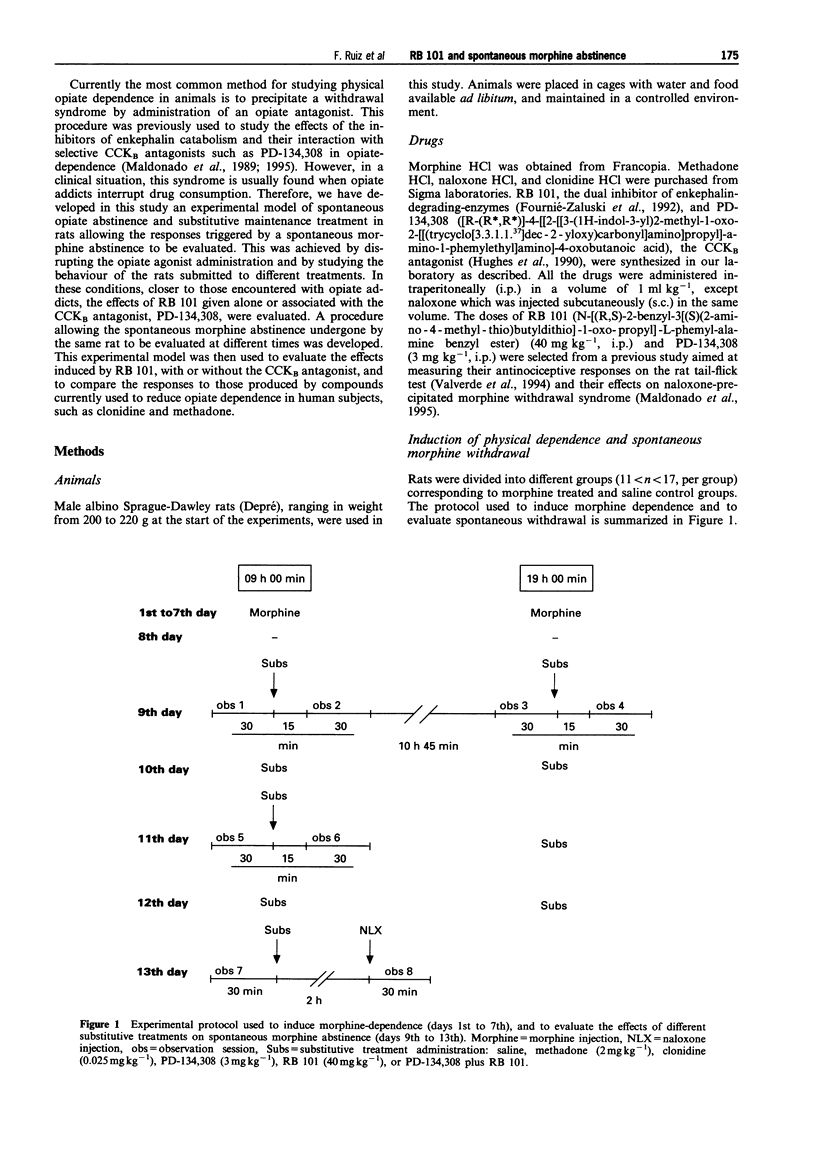
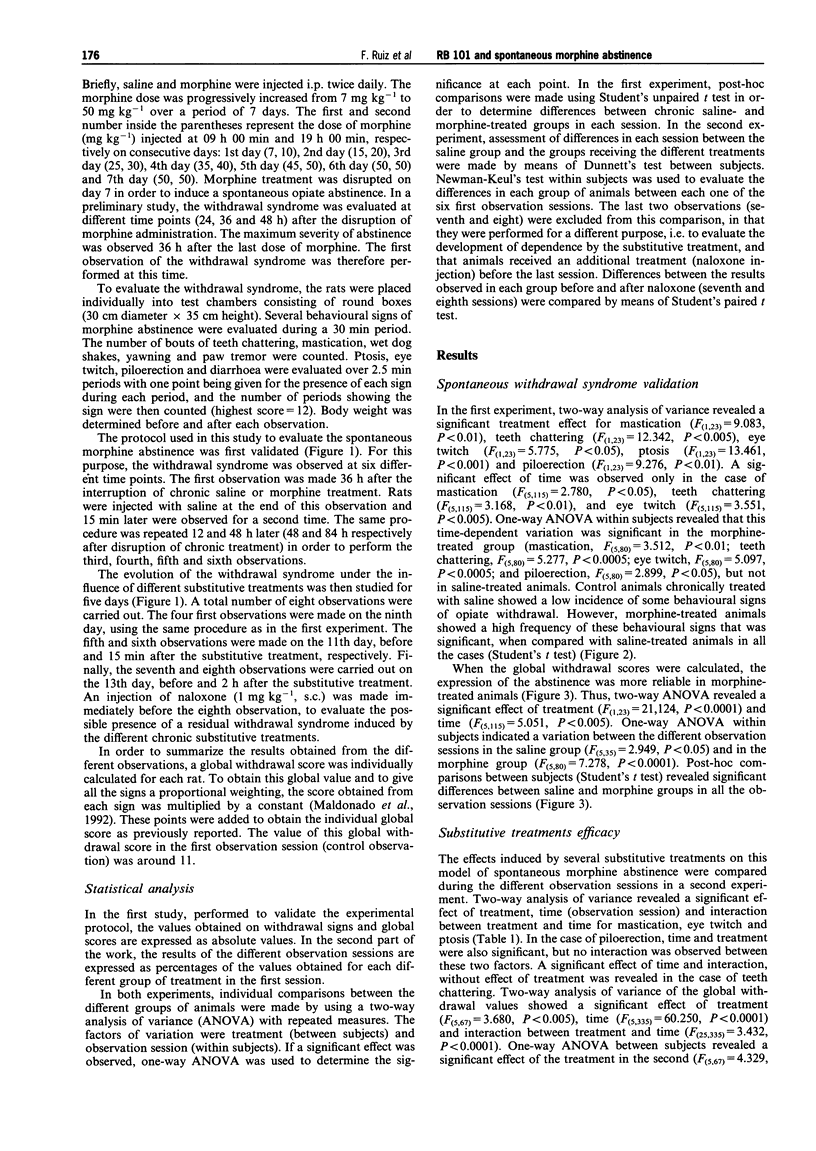

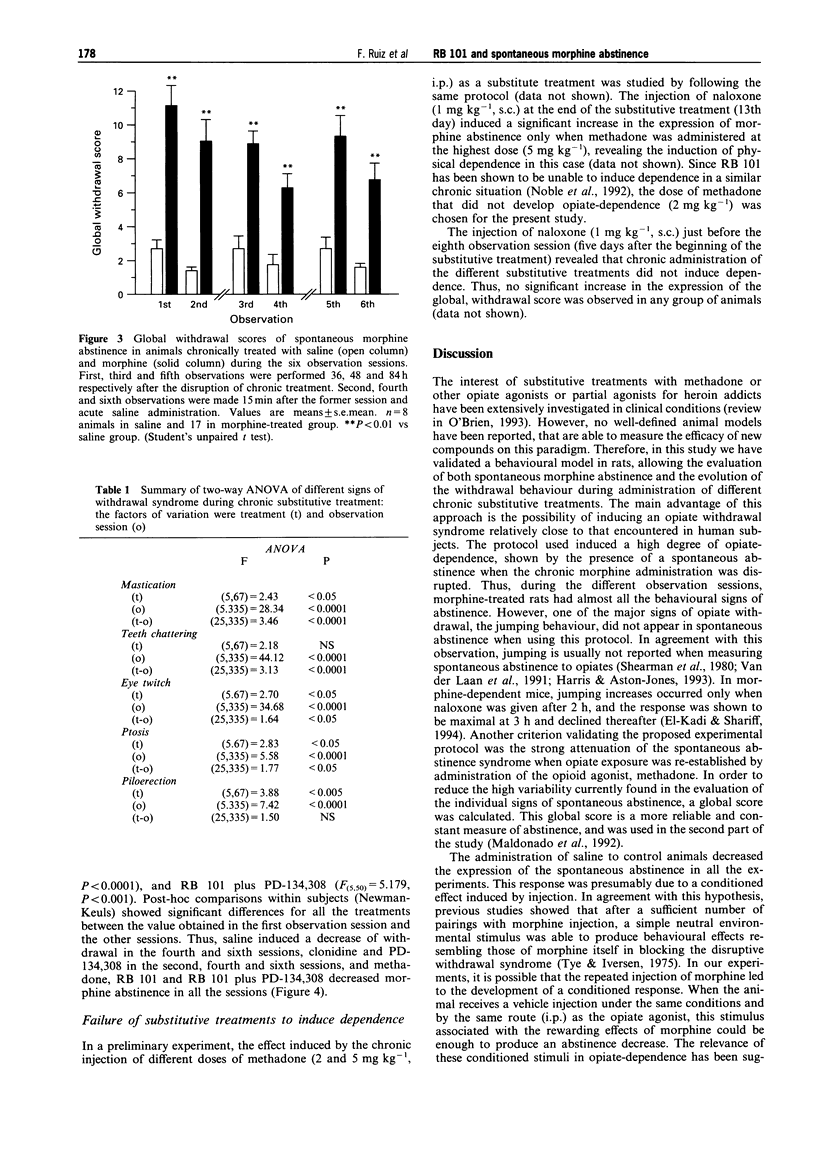

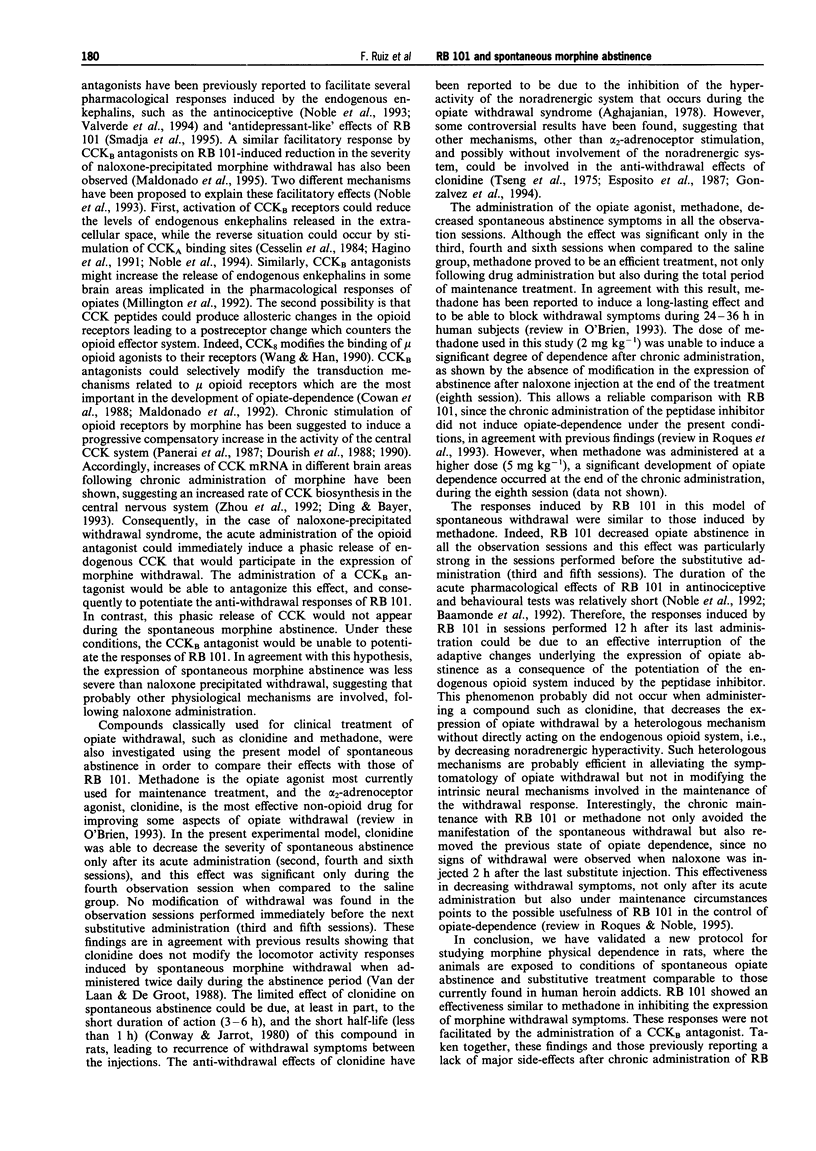
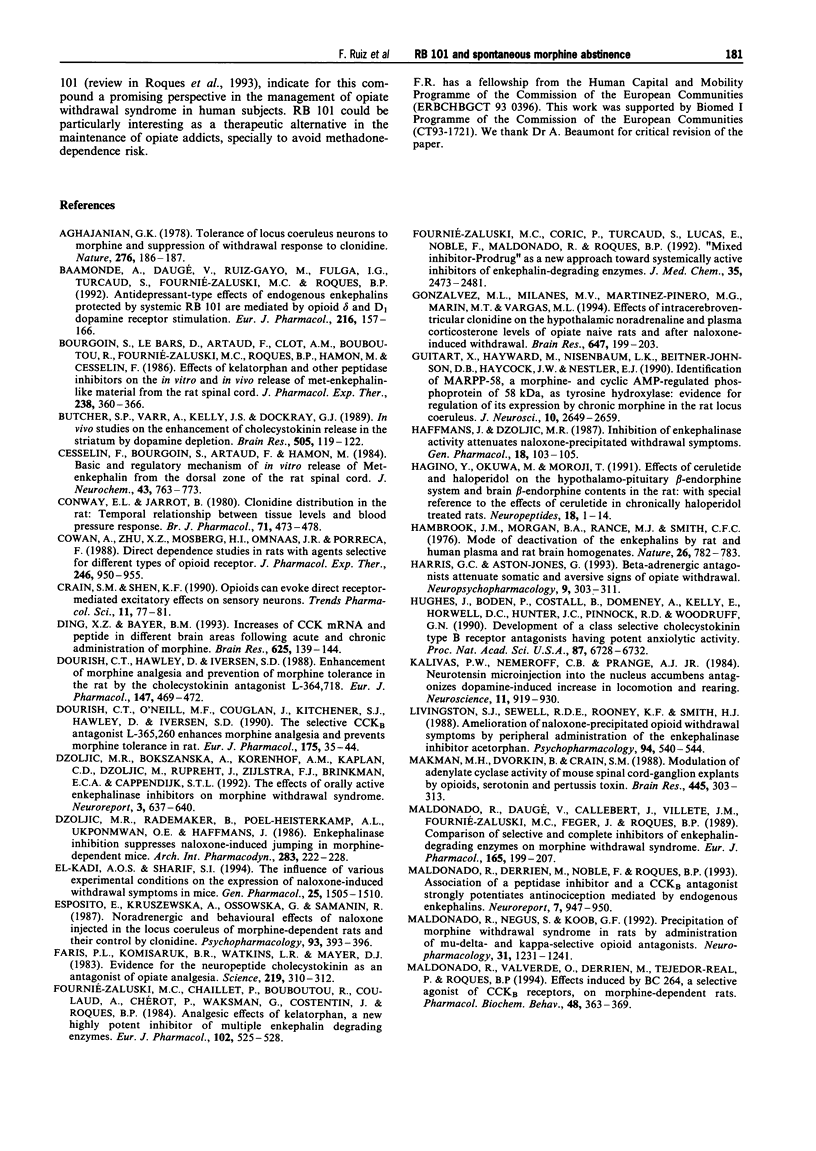
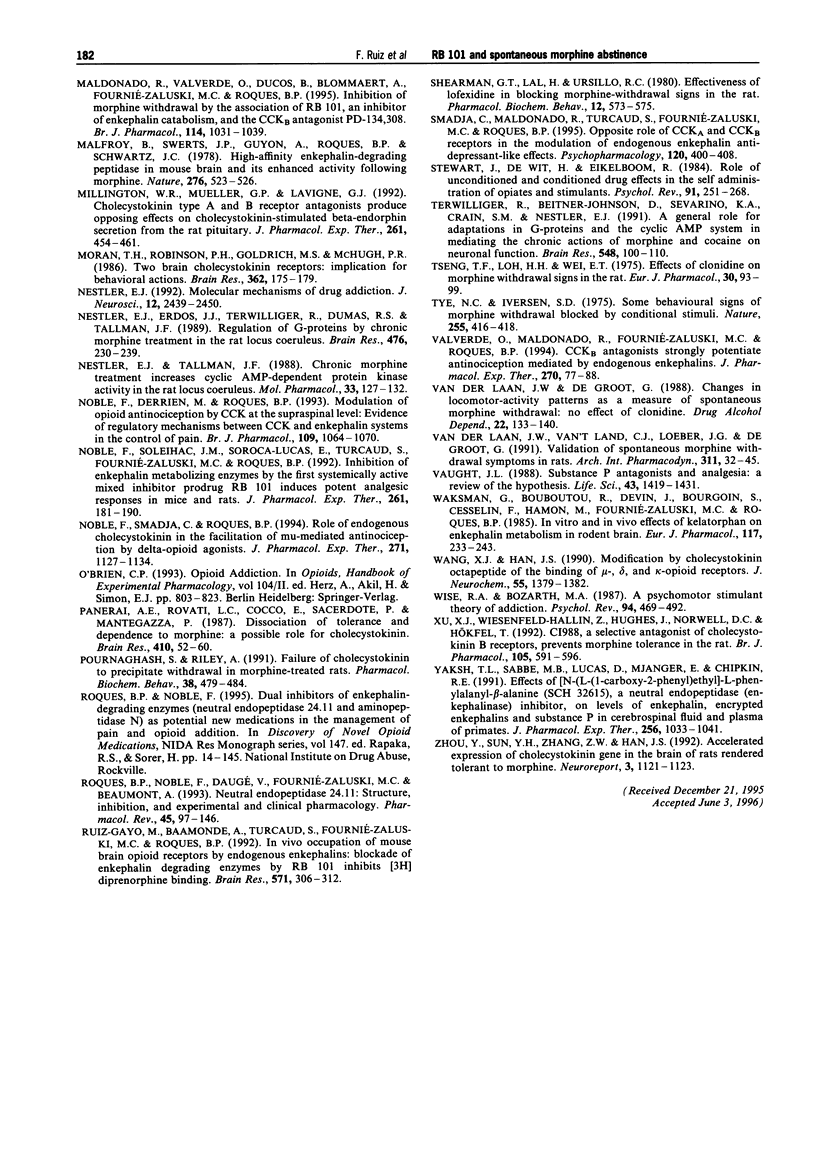
Images in this article
Selected References
These references are in PubMed. This may not be the complete list of references from this article.
- Aghajanian G. K. Tolerance of locus coeruleus neurones to morphine and suppression of withdrawal response by clonidine. Nature. 1978 Nov 9;276(5684):186–188. doi: 10.1038/276186a0. [DOI] [PubMed] [Google Scholar]
- Baamonde A., Daugé V., Ruiz-Gayo M., Fulga I. G., Turcaud S., Fournié-Zaluski M. C., Roques B. P. Antidepressant-type effects of endogenous enkephalins protected by systemic RB 101 are mediated by opioid delta and dopamine D1 receptor stimulation. Eur J Pharmacol. 1992 Jun 5;216(2):157–166. doi: 10.1016/0014-2999(92)90356-9. [DOI] [PubMed] [Google Scholar]
- Bourgoin S., Le Bars D., Artaud F., Clot A. M., Bouboutou R., Fournie-Zaluski M. C., Roques B. P., Hamon M., Cesselin F. Effects of kelatorphan and other peptidase inhibitors on the in vitro and in vivo release of methionine-enkephalin-like material from the rat spinal cord. J Pharmacol Exp Ther. 1986 Jul;238(1):360–366. [PubMed] [Google Scholar]
- Butcher S. P., Varro A., Kelly J. S., Dockray G. J. In vivo studies on the enhancement of cholecystokinin release in the rat striatum by dopamine depletion. Brain Res. 1989 Dec 25;505(1):119–122. doi: 10.1016/0006-8993(89)90121-2. [DOI] [PubMed] [Google Scholar]
- Cesselin F., Bourgoin S., Artaud F., Hamon M. Basic and regulatory mechanisms of in vitro release of Met-enkephalin from the dorsal zone of the rat spinal cord. J Neurochem. 1984 Sep;43(3):763–774. doi: 10.1111/j.1471-4159.1984.tb12798.x. [DOI] [PubMed] [Google Scholar]
- Conway E. L., Jarrott B. Clonidine distribution in the rat: temporal relationship between tissue levels and blood pressure response. Br J Pharmacol. 1980;71(2):473–478. doi: 10.1111/j.1476-5381.1980.tb10960.x. [DOI] [PMC free article] [PubMed] [Google Scholar]
- Cowan A., Zhu X. Z., Mosberg H. I., Omnaas J. R., Porreca F. Direct dependence studies in rats with agents selective for different types of opioid receptor. J Pharmacol Exp Ther. 1988 Sep;246(3):950–955. [PubMed] [Google Scholar]
- Crain S. M., Shen K. F. Opioids can evoke direct receptor-mediated excitatory effects on sensory neurons. Trends Pharmacol Sci. 1990 Feb;11(2):77–81. doi: 10.1016/0165-6147(90)90322-y. [DOI] [PubMed] [Google Scholar]
- Ding X. Z., Bayer B. M. Increases of CCK mRNA and peptide in different brain areas following acute and chronic administration of morphine. Brain Res. 1993 Oct 15;625(1):139–144. doi: 10.1016/0006-8993(93)90146-e. [DOI] [PubMed] [Google Scholar]
- Dourish C. T., Hawley D., Iversen S. D. Enhancement of morphine analgesia and prevention of morphine tolerance in the rat by the cholecystokinin antagonist L-364,718. Eur J Pharmacol. 1988 Mar 15;147(3):469–472. doi: 10.1016/0014-2999(88)90183-5. [DOI] [PubMed] [Google Scholar]
- Dourish C. T., O'Neill M. F., Coughlan J., Kitchener S. J., Hawley D., Iversen S. D. The selective CCK-B receptor antagonist L-365,260 enhances morphine analgesia and prevents morphine tolerance in the rat. Eur J Pharmacol. 1990 Jan 25;176(1):35–44. doi: 10.1016/0014-2999(90)90129-t. [DOI] [PubMed] [Google Scholar]
- Dzoljic M. R., Bokszanska A., Korenhof A. M., Kaplan C. D., Dzoljic M., Rupreht J., Zijlstra F. J., Brinkman E. C., Cappendijk S. L. The effects of orally active enkephalinase inhibitors on morphine withdrawal syndrome. Neuroreport. 1992 Jul;3(7):637–640. doi: 10.1097/00001756-199207000-00024. [DOI] [PubMed] [Google Scholar]
- Dzoljic M. R., Rademaker B., vd Poel-Heisterkamp A. L., Ukponmwan O. E., Haffmans J. Enkephalinase inhibition suppresses naloxone-induced jumping in morphine-dependent mice. Arch Int Pharmacodyn Ther. 1986 Oct;283(2):222–228. [PubMed] [Google Scholar]
- Esposito E., Kruszewska A., Ossowska G., Samanin R. Noradrenergic and behavioural effects of naloxone injected in the locus coeruleus of morphine-dependent rats and their control by clonidine. Psychopharmacology (Berl) 1987;93(3):393–396. doi: 10.1007/BF00187263. [DOI] [PubMed] [Google Scholar]
- Faris P. L., Komisaruk B. R., Watkins L. R., Mayer D. J. Evidence for the neuropeptide cholecystokinin as an antagonist of opiate analgesia. Science. 1983 Jan 21;219(4582):310–312. doi: 10.1126/science.6294831. [DOI] [PubMed] [Google Scholar]
- Fournie-Zaluski M. C., Chaillet P., Bouboutou R., Coulaud A., Cherot P., Waksman G., Costentin J., Roques B. P. Analgesic effects of kelatorphan, a new highly potent inhibitor of multiple enkephalin degrading enzymes. Eur J Pharmacol. 1984 Jul 20;102(3-4):525–528. doi: 10.1016/0014-2999(84)90575-2. [DOI] [PubMed] [Google Scholar]
- Fournié-Zaluski M. C., Coric P., Turcaud S., Lucas E., Noble F., Maldonado R., Roques B. P. "Mixed inhibitor-prodrug" as a new approach toward systemically active inhibitors of enkephalin-degrading enzymes. J Med Chem. 1992 Jun 26;35(13):2473–2481. doi: 10.1021/jm00091a016. [DOI] [PubMed] [Google Scholar]
- Gonzalvez M. L., Milanés M. V., Martinez-Piñero M. G., Marín M. T., Vargas M. L. Effects of intracerebroventricular clonidine on the hypothalamic noradrenaline and plasma corticosterone levels of opiate naive rats and after naloxone-induced withdrawal. Brain Res. 1994 Jun 6;647(2):199–203. doi: 10.1016/0006-8993(94)91318-8. [DOI] [PubMed] [Google Scholar]
- Guitart X., Hayward M., Nisenbaum L. K., Beitner-Johnson D. B., Haycock J. W., Nestler E. J. Identification of MARPP-58, a morphine- and cyclic AMP-regulated phosphoprotein of 58 kDa, as tyrosine hydroxylase: evidence for regulation of its expression by chronic morphine in the rat locus coeruleus. J Neurosci. 1990 Aug;10(8):2649–2659. doi: 10.1523/JNEUROSCI.10-08-02649.1990. [DOI] [PMC free article] [PubMed] [Google Scholar]
- Haffmans J., Dzoljic M. R. Inhibition of enkephalinase activity attenuates naloxone-precipitated withdrawal symptoms. Gen Pharmacol. 1987;18(1):103–105. doi: 10.1016/0306-3623(87)90179-0. [DOI] [PubMed] [Google Scholar]
- Hagino Y., Okuwa M., Moroji T. Effects of ceruletide and haloperidol on the hypothalamo-pituitary beta-endorphin system and brain beta-endorphin contents in the rat: with special reference to effects of ceruletide in chronically haloperidol-treated rats. Neuropeptides. 1991 Jan;18(1):1–14. doi: 10.1016/0143-4179(91)90157-e. [DOI] [PubMed] [Google Scholar]
- Hambrook J. M., Morgan B. A., Rance M. J., Smith C. F. Mode of deactivation of the enkephalins by rat and human plasma and rat brain homogenates. Nature. 1976 Aug 26;262(5571):782–783. doi: 10.1038/262782a0. [DOI] [PubMed] [Google Scholar]
- Harris G. C., Aston-Jones G. Beta-adrenergic antagonists attenuate somatic and aversive signs of opiate withdrawal. Neuropsychopharmacology. 1993 Dec;9(4):303–311. doi: 10.1038/npp.1993.66. [DOI] [PubMed] [Google Scholar]
- Hughes J., Boden P., Costall B., Domeney A., Kelly E., Horwell D. C., Hunter J. C., Pinnock R. D., Woodruff G. N. Development of a class of selective cholecystokinin type B receptor antagonists having potent anxiolytic activity. Proc Natl Acad Sci U S A. 1990 Sep;87(17):6728–6732. doi: 10.1073/pnas.87.17.6728. [DOI] [PMC free article] [PubMed] [Google Scholar]
- Kalivas P. W., Nemeroff C. B., Prange A. J., Jr Neurotensin microinjection into the nucleus accumbens antagonizes dopamine-induced increase in locomotion and rearing. Neuroscience. 1984 Apr;11(4):919–930. doi: 10.1016/0306-4522(84)90203-3. [DOI] [PubMed] [Google Scholar]
- Livingston S. J., Sewell R. D., Rooney K. F., Smith H. J. Amelioration of naloxone-precipitated opioid withdrawal symptoms by peripheral administration of the enkephalinase inhibitor acetorphan. Psychopharmacology (Berl) 1988;94(4):540–544. doi: 10.1007/BF00212852. [DOI] [PubMed] [Google Scholar]
- Makman M. H., Dvorkin B., Crain S. M. Modulation of adenylate cyclase activity of mouse spinal cord-ganglion explants by opioids, serotonin and pertussis toxin. Brain Res. 1988 Apr 5;445(2):303–313. doi: 10.1016/0006-8993(88)91193-6. [DOI] [PubMed] [Google Scholar]
- Maldonado R., Daugé V., Callebert J., Villette J. M., Fournié-Zaluski M. C., Feger J., Roques B. P. Comparison of selective and complete inhibitors of enkephalin-degrading enzymes on morphine withdrawal syndrome. Eur J Pharmacol. 1989 Jun 20;165(2-3):199–207. doi: 10.1016/0014-2999(89)90713-9. [DOI] [PubMed] [Google Scholar]
- Maldonado R., Derrien M., Noble F., Roques B. P. Association of the peptidase inhibitor RB 101 and a CCK-B antagonist strongly enhances antinociceptive responses. Neuroreport. 1993 Jul;4(7):947–950. doi: 10.1097/00001756-199307000-00028. [DOI] [PubMed] [Google Scholar]
- Maldonado R., Negus S., Koob G. F. Precipitation of morphine withdrawal syndrome in rats by administration of mu-, delta- and kappa-selective opioid antagonists. Neuropharmacology. 1992 Dec;31(12):1231–1241. doi: 10.1016/0028-3908(92)90051-p. [DOI] [PubMed] [Google Scholar]
- Maldonado R., Valverde O., Derrien M., Tejedor-Real P., Roques B. P. Effects induced by BC 264, a selective agonist of CCK-B receptors, on morphine-dependent rats. Pharmacol Biochem Behav. 1994 Jun;48(2):363–369. doi: 10.1016/0091-3057(94)90539-8. [DOI] [PubMed] [Google Scholar]
- Maldonado R., Valverde O., Ducos B., Blommaert A. G., Fournie-Zaluski M. C., Roques B. P. Inhibition of morphine withdrawal by the association of RB 101, an inhibitor of enkephalin catabolism, and the CCKB antagonist PD-134,308. Br J Pharmacol. 1995 Mar;114(5):1031–1039. doi: 10.1111/j.1476-5381.1995.tb13309.x. [DOI] [PMC free article] [PubMed] [Google Scholar]
- Malfroy B., Swerts J. P., Guyon A., Roques B. P., Schwartz J. C. High-affinity enkephalin-degrading peptidase in brain is increased after morphine. Nature. 1978 Nov 30;276(5687):523–526. doi: 10.1038/276523a0. [DOI] [PubMed] [Google Scholar]
- Millington W. R., Mueller G. P., Lavigne G. J. Cholecystokinin type A and type B receptor antagonists produce opposing effects on cholecystokinin-stimulated beta-endorphin secretion from the rat pituitary. J Pharmacol Exp Ther. 1992 May;261(2):454–461. [PubMed] [Google Scholar]
- Moran T. H., Robinson P. H., Goldrich M. S., McHugh P. R. Two brain cholecystokinin receptors: implications for behavioral actions. Brain Res. 1986 Jan 1;362(1):175–179. doi: 10.1016/0006-8993(86)91413-7. [DOI] [PubMed] [Google Scholar]
- Nestler E. J., Erdos J. J., Terwilliger R., Duman R. S., Tallman J. F. Regulation of G proteins by chronic morphine in the rat locus coeruleus. Brain Res. 1989 Jan 9;476(2):230–239. doi: 10.1016/0006-8993(89)91243-2. [DOI] [PubMed] [Google Scholar]
- Nestler E. J. Molecular mechanisms of drug addiction. J Neurosci. 1992 Jul;12(7):2439–2450. doi: 10.1523/JNEUROSCI.12-07-02439.1992. [DOI] [PMC free article] [PubMed] [Google Scholar]
- Nestler E. J., Tallman J. F. Chronic morphine treatment increases cyclic AMP-dependent protein kinase activity in the rat locus coeruleus. Mol Pharmacol. 1988 Feb;33(2):127–132. [PubMed] [Google Scholar]
- Noble F., Derrien M., Roques B. P. Modulation of opioid antinociception by CCK at the supraspinal level: evidence of regulatory mechanisms between CCK and enkephalin systems in the control of pain. Br J Pharmacol. 1993 Aug;109(4):1064–1070. doi: 10.1111/j.1476-5381.1993.tb13730.x. [DOI] [PMC free article] [PubMed] [Google Scholar]
- Noble F., Smadja C., Roques B. P. Role of endogenous cholecystokinin in the facilitation of mu-mediated antinociception by delta-opioid agonists. J Pharmacol Exp Ther. 1994 Dec;271(3):1127–1134. [PubMed] [Google Scholar]
- Noble F., Soleilhac J. M., Soroca-Lucas E., Turcaud S., Fournie-Zaluski M. C., Roques B. P. Inhibition of the enkephalin-metabolizing enzymes by the first systemically active mixed inhibitor prodrug RB 101 induces potent analgesic responses in mice and rats. J Pharmacol Exp Ther. 1992 Apr;261(1):181–190. [PubMed] [Google Scholar]
- Panerai A. E., Rovati L. C., Cocco E., Sacerdote P., Mantegazza P. Dissociation of tolerance and dependence to morphine: a possible role for cholecystokinin. Brain Res. 1987 Apr 28;410(1):52–60. doi: 10.1016/s0006-8993(87)80019-7. [DOI] [PubMed] [Google Scholar]
- Pournaghash S., Riley A. L. Failure of cholecystokinin to precipitate withdrawal in morphine-treated rats. Pharmacol Biochem Behav. 1991 Mar;38(3):479–484. doi: 10.1016/0091-3057(91)90001-i. [DOI] [PubMed] [Google Scholar]
- Roques B. P., Noble F., Daugé V., Fournié-Zaluski M. C., Beaumont A. Neutral endopeptidase 24.11: structure, inhibition, and experimental and clinical pharmacology. Pharmacol Rev. 1993 Mar;45(1):87–146. [PubMed] [Google Scholar]
- Roques B. P., Noble F. Dual inhibitors of enkephalin-degrading enzymes (neutral endopeptidase 24.11 and aminopeptidase N) as potential new medications in the management of pain and opioid addiction. NIDA Res Monogr. 1995;147:104–145. [PubMed] [Google Scholar]
- Ruiz-Gayo M., Baamonde A., Turcaud S., Fournie-Zaluski M. C., Roques B. P. In vivo occupation of mouse brain opioid receptors by endogenous enkephalins: blockade of enkephalin degrading enzymes by RB 101 inhibits [3H]diprenorphine binding. Brain Res. 1992 Feb 7;571(2):306–312. doi: 10.1016/0006-8993(92)90669-z. [DOI] [PubMed] [Google Scholar]
- Shearman G. T., Lal H., Ursillo R. C. Effectiveness of lofexidine in blocking morphine-withdrawal signs in the rat. Pharmacol Biochem Behav. 1980 Apr;12(4):573–575. doi: 10.1016/0091-3057(80)90191-4. [DOI] [PubMed] [Google Scholar]
- Smadja C., Maldonado R., Turcaud S., Fournie-Zaluski M. C., Roques B. P. Opposite role of CCKA and CCKB receptors in the modulation of endogenous enkephalin antidepressant-like effects. Psychopharmacology (Berl) 1995 Aug;120(4):400–408. doi: 10.1007/BF02245811. [DOI] [PubMed] [Google Scholar]
- Stewart J., de Wit H., Eikelboom R. Role of unconditioned and conditioned drug effects in the self-administration of opiates and stimulants. Psychol Rev. 1984 Apr;91(2):251–268. [PubMed] [Google Scholar]
- Terwilliger R. Z., Beitner-Johnson D., Sevarino K. A., Crain S. M., Nestler E. J. A general role for adaptations in G-proteins and the cyclic AMP system in mediating the chronic actions of morphine and cocaine on neuronal function. Brain Res. 1991 May 10;548(1-2):100–110. doi: 10.1016/0006-8993(91)91111-d. [DOI] [PubMed] [Google Scholar]
- Tseng L. F., Loh H. H., Wei E. T. Effects of clonidine on morphine withdrawal signs in the rat. Eur J Pharmacol. 1975 Jan;30(1):93–99. doi: 10.1016/0014-2999(75)90208-3. [DOI] [PubMed] [Google Scholar]
- Tye N. C., Iversen S. D. Some behavioural signs of morphine withdrawal blocked by condition stimuli. Nature. 1975 May 29;255(5507):416–418. doi: 10.1038/255416a0. [DOI] [PubMed] [Google Scholar]
- Valverde O., Maldonado R., Fournie-Zaluski M. C., Roques B. P. Cholecystokinin B antagonists strongly potentiate antinociception mediated by endogenous enkephalins. J Pharmacol Exp Ther. 1994 Jul;270(1):77–88. [PubMed] [Google Scholar]
- Vaught J. L. Substance P antagonists and analgesia: a review of the hypothesis. Life Sci. 1988;43(18):1419–1431. doi: 10.1016/0024-3205(88)90253-6. [DOI] [PubMed] [Google Scholar]
- Waksman G., Bouboutou R., Devin J., Bourgoin S., Cesselin F., Hamon M., Fournie-Zaluski M. C., Roques B. In vitro and in vivo effects of kelatorphan on enkephalin metabolism in rodent brain. Eur J Pharmacol. 1985 Nov 5;117(2):233–243. doi: 10.1016/0014-2999(85)90608-9. [DOI] [PubMed] [Google Scholar]
- Wang X. J., Han J. S. Modification by cholecystokinin octapeptide of the binding of mu-, delta-, and kappa-opioid receptors. J Neurochem. 1990 Oct;55(4):1379–1382. doi: 10.1111/j.1471-4159.1990.tb03149.x. [DOI] [PubMed] [Google Scholar]
- Wise R. A., Bozarth M. A. A psychomotor stimulant theory of addiction. Psychol Rev. 1987 Oct;94(4):469–492. [PubMed] [Google Scholar]
- Xu X. J., Wiesenfeld-Hallin Z., Hughes J., Horwell D. C., Hökfelt T. CI988, a selective antagonist of cholecystokininB receptors, prevents morphine tolerance in the rat. Br J Pharmacol. 1992 Mar;105(3):591–596. doi: 10.1111/j.1476-5381.1992.tb09024.x. [DOI] [PMC free article] [PubMed] [Google Scholar]
- Yaksh T. L., Sabbe M. B., Lucas D., Mjanger E., Chipkin R. E. Effects of [N-(L-(1-carboxy-2-phenyl)ethyl]-L-phenylalanyl-beta-alanine (SCH32615), a neutral endopeptidase (enkephalinase) inhibitor, on levels of enkephalin, encrypted enkephalins and substance P in cerebrospinal fluid and plasma of primates. J Pharmacol Exp Ther. 1991 Mar;256(3):1033–1041. [PubMed] [Google Scholar]
- Zhou Y., Sun Y. H., Zhang Z. W., Han J. S. Accelerated expression of cholecystokinin gene in the brain of rats rendered tolerant to morphine. Neuroreport. 1992 Dec;3(12):1121–1123. doi: 10.1097/00001756-199212000-00022. [DOI] [PubMed] [Google Scholar]
- el-Kadi A. O., Sharif S. I. The influence of various experimental conditions on the expression of naloxone-induced withdrawal symptoms in mice. Gen Pharmacol. 1994 Nov;25(7):1505–1510. doi: 10.1016/0306-3623(94)90181-3. [DOI] [PubMed] [Google Scholar]
- van der Laan J. W., de Groot G. Changes in locomotor-activity patterns as a measure of spontaneous morphine withdrawal: no effect of clonidine. Drug Alcohol Depend. 1988 Oct;22(1-2):133–140. doi: 10.1016/0376-8716(88)90048-8. [DOI] [PubMed] [Google Scholar]
- van der Laan J. W., van 't Land C. J., Loeber J. G., de Groot G. Validation of spontaneous morphine withdrawal symptoms in rats. Arch Int Pharmacodyn Ther. 1991 May-Jun;311:32–45. [PubMed] [Google Scholar]



